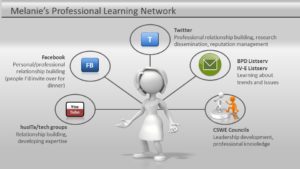Creating an Infographic in a Social Work Course: A Student’s Perspective from Danielle Davis
Last year, Dr. Nathalie P. Jones, from the Department of Social Work at Tarleton State University, wrote a blog post about her experience with a tech-meditated assignment for her social work courses – creating an infographic. She frequently uses technology in her classrooms to help students improve their digital literacy skills, and specifically uses infographics as tools for digital storytelling. As a follow-up to Dr. Jones’ post, I asked one her students, Danielle Davis, to share her thoughts on the assignment, what it was like to create an infographic, and how the knowledge and skills from the assignment might be incorporated in her future role as a social worker. Here are Danielle’s responses to my questions:
What were your initial reaction to the infographic assignment?
I was very hesitant when Dr. Jones initially discussed the infographic assignment in our service learning course. It was the second week of my social work undergraduate program, and I remember wondering if anyone else was as confused as I felt in that moment. I was worried about not being able to complete the assignment according to the grading rubric. I had never created an infographic before, however, I was willing to try. The infographic assignment allowed me the opportunity to be creative and share the information learned about working with vulnerable populations. Being able to use my creative side in an assignment was very appealing.
How did your reaction change over the semester?
Over the semester my reaction to the assignment changed entirely. As we worked on the various steps in the assignment, I started to gain a better understanding about the importance of an infographic and how they can be used. The infographic assignment ended up being my favorite assignment. I enjoyed being able to take a social work issue that mattered, build the infographic that reflected real statistics, and then share the information in Twitter to a large, public audience. I was amazed that people from all over the nation could come together in one place on social media and share information about social work by using infographics.
Social Work and the Open Education Movement
Editor’s Note: Matthew DeCarlo is an assistant professor of social work in the School of Social Work at Radford University. In this blog post, he describes the open educational resources (OER) movement and how social work educators can get involved.
Why should social work care about open educational resources?
The rising cost of textbooks is an issue of social justice for social work education. The average undergraduate student in the United States, according to The College Board (2017), spends $1250 on textbooks each academic year. Two years ago, the Bureau of Labor Statistics (2016) reported the cost of textbooks increased at a faster rate (87.5%) than tuition (62.7%), housing (50.5%), and all other student costs. Students report that textbook costs are more financially stressful than meals and food, healthcare, and housing—with 43% skipping meals and 70% getting a job to pay for textbooks (Cengage, 2018).
Although dollar-for-dollar, textbooks are less of a financial burden to students than other costs, the high cost of textbooks negatively impacts student academic performance and retention. A survey of all students at Florida higher education institutions found that due to high textbook prices, 67% of students do not purchase the required textbook, 38% of students receive poor grades because they could not afford the textbook, 20% fail a course because they could not afford the textbook, 48% take fewer courses, 46% avoid registering for a class, 48% drop a class, and 26% withdraw from a course (Florida Virtual Campus, 2016).
One solution, as proposed by traditional textbook publishers, is for students to pay for subscriptions that turn textbooks from a good into a service, like Netflix or Spotify. In this model, students rent access to digital editions of textbooks which can be viewed in the publisher’s platform. Given the high price of textbooks, publishers point to the idea that students are okay with this bargain—lower prices for rented digital books viewable in a publisher’s proprietary app.
Professors, on the other hand, should be suspicious of subscription platforms and their implications for academic freedom. Unlike Spotify, which catalogs music from nearly every music publisher worldwide, subscription platforms will be balkanized. For example, only Cengage books will be offered in Cengage Unlimited. In that case, if an educator prefers a book published by Pearson or McGraw Hill to teach a course, they may find it difficult or impossible to adopt it if their department, institution, or students already subscribe to a different service.
Another solution to skyrocketing textbook costs proposed by publishers is “inclusive access.” Billed as a solution for both professors and students, “inclusive access” allows students to rent access to a less expensive virtual edition of the textbook through a publisher’s proprietary platform. Professors can still choose which book to use, and indeed, publishers will build in customized interactive elements, homework assignments, and other services. If a professor chooses an “inclusive access” text, students face a complicated opt-out process if they prefer a paper textbook and the proprietary applications required to view the material are often inaccessible on mobile devices and for those with disabilities. Additionally, inclusive access rentals often end at the close of the semester, cutting off student access to knowledge and eliminating the used textbook market completely.
Both subscription-based and inclusive access solutions drive home the point that social work knowledge is currently owned by textbook publishers, not the community of social work scholars. In the publishers’ preferred future, that knowledge will not be owned by students and faculty, only rented for a limited time.
Solutions to the broken textbook market
Students engage in a number of clever stopgap solutions to minimize the costs of the broken textbook market. Cost-cutting measures include such innocuous things as sharing a book with a classmate, purchasing a used book, purchasing a previous edition, or buying from an online retailer. Many students will delay the purchase of a book until they know it is absolutely necessary in the course, use the free sample pages on Google or Amazon previews or simply never purchase it at all. Other students will pirate textbooks using Library Genesis or simply by taking pictures of a classmate’s book. Faculty often support these initiatives by allowing old editions of textbooks for a course, negotiating with publishers for lower textbook costs, or simply turning a blind eye to piracy.
Student Placement Software for the Social Work Field Office: Goodbye Post-it Notes!
This month’s guest educator post comes from Kristen Samuels, MSW, MS, MEd, the Field Director for the University of Phoenix’s Department of Social Work. In this blog post, she reviews the “whys” and “hows” of selecting student placement software for your field education office. Kristen can be reached at Kristen.samuels@gmail.com, or @KristenMSamuels on Twitter.
Student placement software are valuable tools when managing the complex processes of Social Work Field Placement. These programs are often web-based and provide easy access for our students, field instructors, and administrators to gather and store information, submit documentation, and obtain reportable data. In reality, field offices often piece together multiple systems to meet all the office needs. This is often because of cost and program features – few affordable student placement programs address all of the needs for a typical field office. In the end, the most important components of student placement software and databases are functional communication between stakeholders, compliance with regulatory requirements, and ease of use.
 Endless platform options are available to manage the student placement process. Depending on the size of your program, your needs will vary, and depending on your budget, your options for platforms will vary. Some institutions are able to manage placements through home-grown efforts (i.e. they design their software in-house) or low-cost proprietary software, such as Google Drive applications, which not only encourage collaboration among the team but are also free to use. A spectrum of other proprietary platforms are available, with varying functionality and associated costs. On the low-cost end of the spectrum, software programs such as Intern Placement Tracking (IPT) allow for form submission (i.e. students and field supervisors complete learning agreements and evaluation forms online) to manage basic logistics, whereas larger programs like 2U provide a placement team with tools to manage a database of affiliated agencies, accreditation support, and more.
Endless platform options are available to manage the student placement process. Depending on the size of your program, your needs will vary, and depending on your budget, your options for platforms will vary. Some institutions are able to manage placements through home-grown efforts (i.e. they design their software in-house) or low-cost proprietary software, such as Google Drive applications, which not only encourage collaboration among the team but are also free to use. A spectrum of other proprietary platforms are available, with varying functionality and associated costs. On the low-cost end of the spectrum, software programs such as Intern Placement Tracking (IPT) allow for form submission (i.e. students and field supervisors complete learning agreements and evaluation forms online) to manage basic logistics, whereas larger programs like 2U provide a placement team with tools to manage a database of affiliated agencies, accreditation support, and more.
How to pick the program that is right for your Field Office?
It is important to develop your own list of needs based on your specific institution and the needs of your field office. Here are some questions to consider when developing that list:
#husITa18/#SWSD2018: Sustaining lifelong learning through the use of Technology-Mediated Professional Learning Networks
On Friday July 6, 2018 at 3:15 PM in the Exhibition Hall at the 2018 International Social Work, Education & Social Development Conference, Melanie Sage, Nancy J. Smyth, Jonathan Singer, and I are presenting a poster about how social workers can use technology for career-long learning, specifically by creating a Professional Learning Network (PLN).
Simply stated, PLNs employ, within an online environment, the same strategy that social work professionals have used for centuries: the practice of connecting to people who share interests and can learn from each other. PLNs are a well-established practice in the field of education (Richardson & Manacebelli, 2011). The term comes from the educational technology learning communities and has its origins in Connectivism, a learning theory developed by George Siemens (2005) to explain how network-based learning occurs in the digital age. Specifically, Connectivism suggests that learning is the process of connecting sources of information together across networks, shifting learning from an individual process to a community effort. Thus, learning includes the skills of managing the flow of information, determining what is and is not useful information, and maintaining connections with others to facilitate on-going learning (Siemens, 2005). All of these skills are developed and applied with a PLN.
We are all big fans of PLNs, and have been sharing the practice with the social work community in the US for over a year now. Nancy, Melanie and I introduced the idea of professional learning networks (PLN) to a packed room of social workers at Social Work Distance Education Conference in April 2017, and have highlighted the practice in our upcoming book with Council on Social Work Education (CSWE) Press – Teaching Social Work with Digital Technology. In October 2017, the three of us along with Jonathan shared tips and tricks for setting up a PLN at CSWE’s Annual Program Meeting. Finally, Melanie and I wrote an article for Social Work Today about PLNs was published in March.
All of us also have our own PLN that we actively employ and nurture for our own professional learning. In the following, we each describe our own PLN:
 Melanie’s PLN: My goal is to build professional relationships around my scholarships interests, and to model positive technology – use for my peers. My PLN includes:
Melanie’s PLN: My goal is to build professional relationships around my scholarships interests, and to model positive technology – use for my peers. My PLN includes:
– husITa and other technology groups: I am a board member of husITa and active with other tech groups. I follow all of them via different social media platforms and share links to technology related content.
– Facebook: I participate in several closed professional social work & technology groups on Facebook for professional reasons, but I mostly use FB to deepen my connections with colleagues and friends.
– Twitter: This is my go-to-app for initial networking as it is easy to find people, quickly learn about their interests, and engage with short posts (under 240 characters).
– Listservs: I belong to several email-based listservs where I can learn about trends and share my own research.
– CSWE Councils: I am a member of a CSWE Council and here is where I work to connect my in-person network with my digital network, by talking to others about how leaders can use social media to connect and share information.





